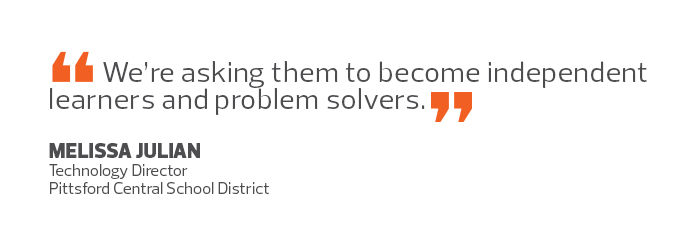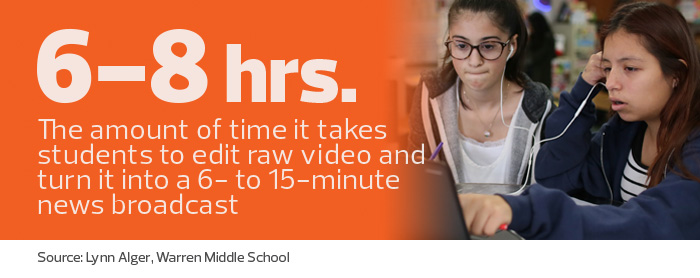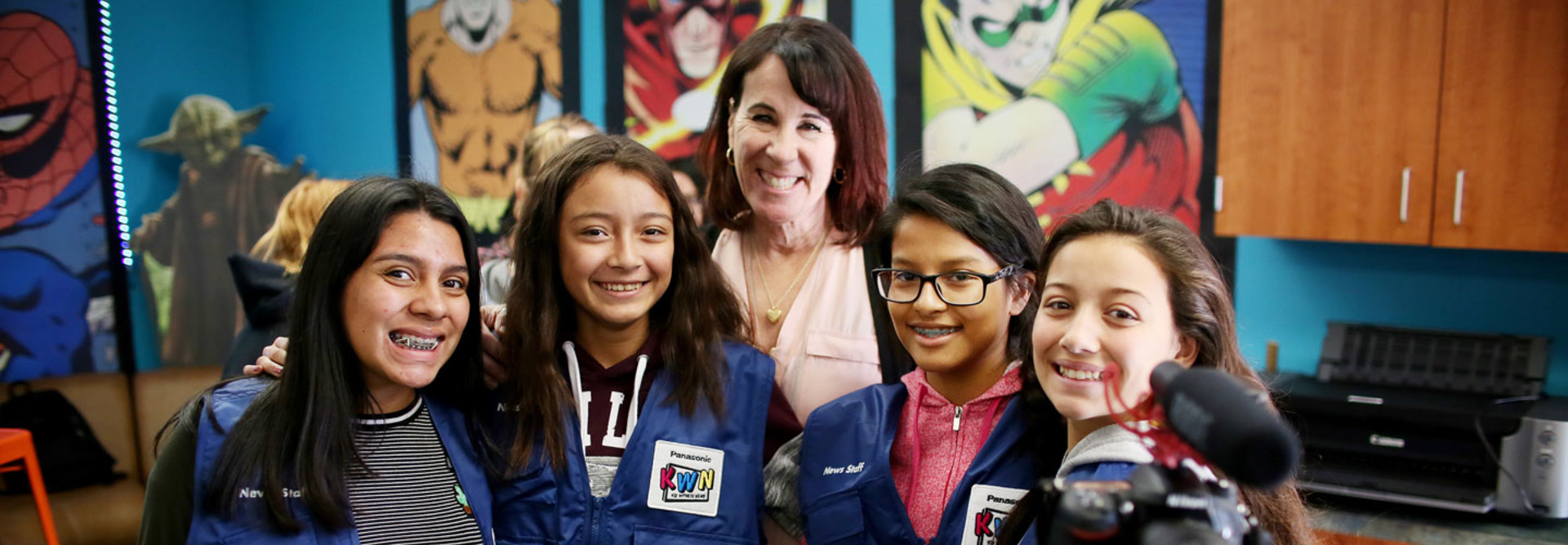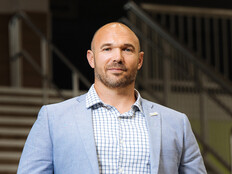Students Adopt Software to Create Digital Stories
Move over, Katie Couric and Ken Burns. A group of students at California’s Vista Unified School District are creating news broadcasts and award-winning short documentary films that are making a difference in their community.
Last spring, 10 students at Rancho Minerva Middle School crafted a four-minute documentary on the importance of digital equity. The young filmmakers explained how students can find free Wi-Fi hotspots in their neighborhoods and interviewed the school principal, who described his efforts to increase students’ broadband access at home.
The video won a national award from CoSN and spurred the school board to purchase 200 mobile wireless hotspots that Rancho Minerva students can borrow and take home at no cost, so they and their family members can have the fast internet access they need, says Beth Duncan, the school’s broadcast journalism and video production teacher.
“We empowered our students to tackle the problem of digital equity in our community and work to solve it, and they made an impact,” she says. “Our students are smart, capable and passionate, and when given the opportunity and the right tools, they are proving they can do work at a high level.”
Online video has become pervasive in the lives of today’s youth thanks to the popularity and ubiquity of YouTube, social media and mobile devices. To better engage students, many school districts embrace digital storytelling and teaching students multimedia skills, such as video production.
Educators say video production allows students to learn about potential careers in broadcasting and filmmaking while honing important skills, such as creativity, critical thinking, communication, collaboration and meeting deadlines. They are also learning valuable technology skills as schools invest in computer labs, digital video cameras and video editing and design software, such as Adobe Creative Cloud.
“We’re asking them to become independent learners and problem solvers,” says Melissa Julian, technology director at Pittsford Central School District in New York. “It’s not a simple book report, where they are taking information and regurgitating it in a similar format. It’s taking artistic license and the concept of storytelling and putting their own spin on things.”
SIGN UP: Get more news from the EdTech newsletter in your inbox every two weeks!
What Is Digital Storytelling?
Districts teach digital storytelling in different ways. Some schools offer electives in broadcast journalism, while others incorporate storytelling projects into core subjects, such as English and social studies.
At the School District of Waukesha in Wisconsin, for example, students in one elementary school are writing and designing their own interactive e-books on the history of Waukesha by using a book-authoring app that allows them to incorporate video and images, says CIO Steve Schlomann, whose district equips every student with a tablet.
Meanwhile, students with developmental disabilities at the district’s Transition Academy are using tablets to record podcasts on different topics. “These are young students who struggle to speak to strangers, but they come alive behind the microphone,” Schlomann says. “This allows them to express themselves without the anxiety of doing it live.”
Teachers Embrace Tech for the Art of Filmmaking
At Rancho Minerva Middle School, Duncan began teaching broadcast journalism and video production six years ago with one point-and-shoot video camera and one desktop computer.
Today, she has expanded to 15 DSLR cameras, 15 desktop computers and five laptops for post-production work. She also provides video editing software that includes Adobe Premiere Pro, as well as microphones, gimbals and a wall painted green to serve as a green screen.

Duncan teaches two broadcast journalism classes each year — beginner and advanced. The more experienced students train the new students on technology, such as how to shoot and edit video.
They collaborate to produce a 10-minute news broadcast every two weeks, which teachers show schoolwide to their classes. Students take turns doing all parts of the production, from storyboarding and writing scripts to filming and editing video and being the on-air talent, she says. Duncan guides them, but allows students to make decisions, such as lighting and shoot locations.
Students also work on special projects and collaborate with schools in Hawaii and Illinois. They meet virtually on Google Hangouts to brainstorm ideas and storyboard and share their scripts on Google Docs. Once they shoot the video, they upload footage onto an online video file-sharing service and take turns doing final edits on each project.
In December, for example, Rancho Minerva students worked together with Kalama Intermediate School in Maui to produce a video on holiday traditions. The Hawaiian students explained the importance of luaus, while Rancho Minerva students talked about making tamales with their families.
“It’s life-changing for the kids,” Duncan says. “This allows them to get to know children from other states and experience other cultures.”
Duncan’s seventh- and eighth-grade students are learning how to use the Adobe suite of products, including Adobe Premiere Pro for video editing and Adobe After Effects for motion graphics.
Students Teach Each Other the Tenets of Tech
Other digital storytelling teachers say they teach students the basics of technology, but for the most part — like Duncan in California — they let students teach each other.
Lynn Alger, a technology teacher at Warren Middle School in Warren, N.J., teaches broadcast journalism to eighth-graders. She instructs them on journalism skills, such as public speaking and interviewing techniques, and demonstrates how to use technology. Her classroom includes Canon EOS digital cameras, 21 Dell desktop PCs and Adobe Premiere Elements video editing software, which is a scaled-down, easier-to-use version of Adobe Premiere Pro.
“It’s intuitive,” she says. “As long as you have a general understanding of technology, you can easily figure it out.”
Her students produce weekly 6- to 15-minute newscasts that are broadcast every Friday during lunch or study hall. For instance, in December, they covered a recent poster contest and produced features on an upcoming school play and holiday boutique.
“I let them take the lead and give them ownership of the process, but if they are struggling for story ideas, I give them hints,” Alger says.
Pittsford Central School District provides multiple video editing applications, from simple to advanced. Students at all grade levels are asked to produce video storytelling projects that align with the district’s curriculum and New York State Common Core Standards, says Tina Jarvis, an instructional technology specialist.
Elementary and middle school students use simpler video editing software such as Windows Movie Maker. But high school students prefer the more advanced Adobe Premiere Pro, says Kristin O’Dell, an English teacher at Mendon High School.
In her Film as Literature course, O’Dell’s students currently create public service announcements using Lenovo ThinkPad notebooks.

In high school, when teachers start a storytelling project, they provide students with instructions on using Adobe Premiere Pro. Jarvis is available to provide guidance. But if students need extra help, they turn to other students or watch training videos on YouTube.
“Many students seem to rise to the challenge of using this software and are not daunted by the sometimes-steep learning curve,” O’Dell says.
Student Video Production Can Make a Difference
Back in California, Duncan’s students have gained recognition in the school district and nationally for their work. Students won a national award from Panasonic for a short documentary they produced of a 92-year-old World War II veteran and a 14-year-old Rancho Minerva student, who discussed patriotism and the importance of family.
The district superintendent has even hired Duncan’s students for video production work.
“Our students are so talented and creative,” Duncan says. “When they come into my classroom, they become filmmakers and producers, and they have everything they need.
Digital Storytelling Beyond the Classroom
Digital storytelling is a powerful educational tool, not only inside the classroom, but also outside. For instance, Waukesha South High School in Wisconsin provides extracurricular activities to help students learn and practice video production.
The school often holds a film festival in the spring, allowing students to showcase their films. Art teacher Tom Mancuso opens up his computer lab, so students who need computer access can use Adobe Creative Cloud’s Premiere Pro and After Effects software to edit and produce their films.
About 15 to 20 students produce short films for the film festival. They range from music videos for their bands to films on social issues.
“Video is a major component of artistic expression,” says Mancuso, who adds that he hopes to offer a creative class on video production as part of the school’s art curriculum in the future.









